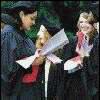 |
|
YORK UNIVERSITY BIOLOGIST LINKS GENES WITH EATING BEHAVIOUR IN RESEARCH TO BE PUBLISHED IN INTERNATIONAL SCIENCE MAGAZINE TORONTO, August 7, 1997 -- A York University biology professor has discovered how genetics influence the way fruit flies forage for food, opening the door to more revelations about the link between genetics and eating behaviour. The results of the study done in the laboratories of Dr. Marla Sokolowski of York University and Dr. Ralph J. Greenspan, a Senior Fellow at the Neurosciences Institute in San Diego, will be published in the August 8 issue of Science magazine, one of the most prestigious science journals in the world. In addition to publishing the results of the study, Science is also devoting a full page to a history of Sokolowski's work and a discussion by international scholars of the significance of these findings. Also contributing to Sokolowski and Greenspan's paper is Kate Osborne, a York University PhD student in biology. "It's a real privilege to have our results published in Science, and for our work to be recognized in this way," said Sokolowski. The magazine has a 90 per cent rejection rate, and before articles reach the pages of the magazine, they must go through a rigorous review process. Sokolowski and Greenspan's study explains, for the first time, why some fruit flies stray far from home to search for food, and others remain close by. They have discovered the chemical, an enzyme, produced by a particular gene that tells flies how to search for their food. "Our findings are significant for humans because they show that small differences in a gene can make a big difference in the behaviour of normal individuals. We have learned a lot about humans from the fruit fly because many fly genes show strong resemblances to our own genes. Versions of the gene we have discovered in the fly are found in the human brain," said Sokolowski. "However, until now, no one has been able to guess what this gene might be doing there. Our work suggests that it would be useful to find out whether this gene plays a role in human eating behaviour. For example, do people with eating disorders differ in the amount of enzyme made by this gene?" These results mark Sokolowski's most recent achievement in what has been a career-long study of the food-search behaviour of fruit flies. She began in 1975, in her third year of undergraduate study, by demonstrating that there are two types of fruit flies in nature, categorized according to how they look for food. "Rovers," which make up about 70 per cent of the normal fruit fly population, range widely in their search for food, while "sitters" stay close to home. Rovers exist in very dense fruit fly populations, where competition for food supplies close to home is quite stiff. Conversely, in uncrowded fly populations, sitters survive better because they don't waste energy looking far for food because it can be found close to home. Since discovering these two groups, Sokolowski has managed to isolate the gene (called dg2) responsible for this distinction, and with this study has now found the molecular basis for this difference, something she admits the scientific community had thought was "next to impossible." "What this new research has found is the chemical made by the gene that actually influences whether a fruit fly is a rover or a sitter," said Sokolowski. "Up to now all we knew was that the dg2 gene was connected in some way to the rover/sitter behaviour." Sokolowski and Greenspan found that the dg2 gene tells a cell in the fruit flies to produce different levels of an enzyme -- the cGMP-dependent-protein-kinase (or PKG). These enzyme levels determine whether the fly is a rover or a sitter. Sokolowski and Greenspan's research shows that that rovers have slightly higher levels of this enzyme in their brains than sitters. In order to prove the connection between the dg2 gene and the PKG enzyme in fruit flies, Sokolowski used genetic engineering to artificially alter the gene. "We used genetic engineering to change the rover/sitter gene so that we could artificially increase and decrease enzyme levels, turning rovers into sitters and back into rovers again. This proves that rover and sitter behaviours result from differences in the PKG levels produced by the dg2 gene. This indicates that environmental factors alone (for example, whether food is scarce or of bad quality) cannot explain these differences in behaviour in the fly," said Sokolowski. But Sokolowski said it's important to recognize that, on the other hand, the rover/sitter gene does not solely determine whether a fly is a rover or a sitter. The rover/sitter gene interacts with other genes and with environmental factors to create the behaviour. "Our next task is to look for these other genes," said Sokolowski. "We want to understand how these genes are influenced by the environment -- factors such as how full the animal is, the quality and availability of food, and how much energy needs to be expended in the search for food." Dr. Sokolowski's work adds to a growing body of scientific research coming out of York University, and reinforces York's international reputation as a destination for students looking for innovative research opportunities and top-notch teaching.
For more information, call:
Marla Sokolowski
Sine MacKinnon
Alison Masemann |
|
|
| | Welcome to York University | Latest Release | Release Archives | |
![[to York's Home Page]](../../images/yorklogos.gif)
